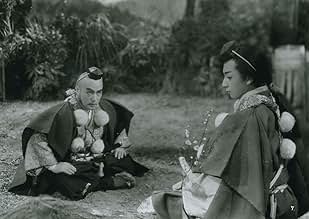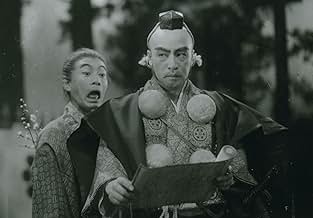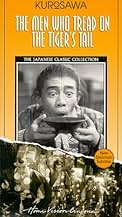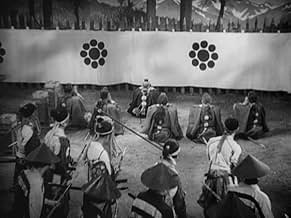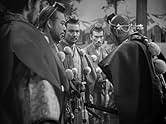Gli uomini che mettono il piede sulla coda della tigre
Titolo originale: Tora no o o fumu otoko-tachi
VALUTAZIONE IMDb
6,7/10
4626
LA TUA VALUTAZIONE
Aggiungi una trama nella tua linguaA Japanese general and his men disguise themselves as monks in order to pass an enemy border patrol.A Japanese general and his men disguise themselves as monks in order to pass an enemy border patrol.A Japanese general and his men disguise themselves as monks in order to pass an enemy border patrol.
- Regia
- Sceneggiatura
- Star
Recensione in evidenza
I chose to watch this on the way home from a trip where Japanese heritage was central. I have saved this early Kurosawa for such a special occasion, knowing that it would be heavily stylized. I thought that would detract from the effect; surely that is what most commentors say.
Cinematically, this has the essential Kurosawa: layered staging, profound cosmic forces testing human resources and strong character extremes.
The central character is disowned royalty, determined to set things right. We see little of him, and not even his face until things are nearly over.
I believe that it is Kurosawa's intention that he be the watcher and motivator both. As our on screen surrogate, this places us as both the watcher and the governing truths. It is a very clever reversal of the tradition, strong even then and even in Japan. The reversal is overt: he/we displace a comic porter, a simpleton that in a slightly less modern story would be the watcher.
He does watch, but as the thing evolves, he becomes more and more a featured act. Coming at the beginning of Kurosawa's career, it is tempting to think of this as paired with "Ran," the fool of the beginning to the King Lear of the end. This fool is not wise, but he is present in a way that no one else is, allowing us to carry the film.
The "film within" in this case is an impromptu prospectus for a rebuilt temple. I know of no more dramatically effective sequence than this, witnessed by an honorable man who takes the blessing seriously, and a foppish villain who creeps around during the speech. These are the fundamentals. As time would go, he could work with something better than a two-layered sound stage, and more complex narratives than this simple vignette. But I think the soul and sound of this is every bit as good as his best.
Ted's Evaluation -- 3 of 3: Worth watching.
Cinematically, this has the essential Kurosawa: layered staging, profound cosmic forces testing human resources and strong character extremes.
The central character is disowned royalty, determined to set things right. We see little of him, and not even his face until things are nearly over.
I believe that it is Kurosawa's intention that he be the watcher and motivator both. As our on screen surrogate, this places us as both the watcher and the governing truths. It is a very clever reversal of the tradition, strong even then and even in Japan. The reversal is overt: he/we displace a comic porter, a simpleton that in a slightly less modern story would be the watcher.
He does watch, but as the thing evolves, he becomes more and more a featured act. Coming at the beginning of Kurosawa's career, it is tempting to think of this as paired with "Ran," the fool of the beginning to the King Lear of the end. This fool is not wise, but he is present in a way that no one else is, allowing us to carry the film.
The "film within" in this case is an impromptu prospectus for a rebuilt temple. I know of no more dramatically effective sequence than this, witnessed by an honorable man who takes the blessing seriously, and a foppish villain who creeps around during the speech. These are the fundamentals. As time would go, he could work with something better than a two-layered sound stage, and more complex narratives than this simple vignette. But I think the soul and sound of this is every bit as good as his best.
Ted's Evaluation -- 3 of 3: Worth watching.
Trama
Lo sapevi?
- QuizProduction had to be halted briefly during production of the film as Japan surrendered, bringing an end to the hostilities of World War II. Akira Kurosawa recollected breaking during production to listen to the address by Emperor Hirohito on August 15th, 1945.
- ConnessioniFeatured in Great Performances: Kurosawa (2000)
I più visti
Accedi per valutare e creare un elenco di titoli salvati per ottenere consigli personalizzati
- How long is The Men Who Tread on the Tiger's Tail?Powered by Alexa
Dettagli
- Data di uscita
- Paese di origine
- Lingua
- Celebre anche come
- The Men Who Tread on the Tiger's Tail
- Luoghi delle riprese
- Toho Studios, Tokyo, Giappone(Studio)
- Azienda produttrice
- Vedi altri crediti dell’azienda su IMDbPro
- Tempo di esecuzione59 minuti
- Colore
- Mix di suoni
- Proporzioni
- 1.37 : 1
Contribuisci a questa pagina
Suggerisci una modifica o aggiungi i contenuti mancanti

Divario superiore
By what name was Gli uomini che mettono il piede sulla coda della tigre (1945) officially released in Canada in English?
Rispondi







